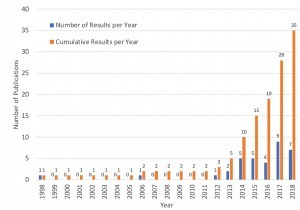Soft robotic devices have many desirable features for minimally invasive surgery (MIS) applications, but many interdisciplinary challenges remain unresolved. To understand the current state of the technologies, a keyword search was performed using the Web of Science and Scopus databases. From the resulting list of articles, a selection of articles was made based on inclusion and exclusion criteria, which were used to compare various features of soft robotic devices for MIS. There was a low diversity in device designs and a high level of detail in technical capabilities. We propose a standardized comparison methodology to characterize soft robotics for different MIS applications to help designers in the production of the next generation of devices.
Literature review
 Fig. 1: Number of results and cumulative results per yearAkeyword search was conducted on the Web of Science and Scopus for articles describing soft robotic devices developed for use in surgery or MIS procedures. The keyword searches used in the selected databases with the corresponding Boolean operators and syntax are summarized in Table 1. The reference lists of these articles and other similar articles were also used as a source for a small portion of the additional search results. The inclusion and exclusion criteria described below were then applied and duplicate articles were removed. This resulted in 35 original articles, each describing a soft robotic device for use in minimally invasive applications.
Fig. 1: Number of results and cumulative results per yearAkeyword search was conducted on the Web of Science and Scopus for articles describing soft robotic devices developed for use in surgery or MIS procedures. The keyword searches used in the selected databases with the corresponding Boolean operators and syntax are summarized in Table 1. The reference lists of these articles and other similar articles were also used as a source for a small portion of the additional search results. The inclusion and exclusion criteria described below were then applied and duplicate articles were removed. This resulted in 35 original articles, each describing a soft robotic device for use in minimally invasive applications.
Inclusion criteria:
- The article described the design and/or manufacture of a robotic device
- The device described was made of soft materials and was based on principles of soft robotics
- The main application for the device was surgery, MIS, endoscopy, laparoscopy, bronchoscopy, colonoscopy or catheterization
- The article was written in English
- The article was accessible to the author at the time of the search.
Exclusion criteria:
- The device described was not designed for use in MIS procedures
- The device was not compliant, or it contained too many rigid parts that could be easily compressed.
Since about 2013, interest has increased each year, as indicated by the number and cumulative total of search results shown in Figure 1. This may have been influenced by the STIFF-FLOP project [18] on the surgical manipulator, which began in 2012.
|
database |
Search terms |
Number of results |
Date |
|
Web of Science |
TS = (soft robot) AND TS = (MIS OR minimally invasive OR (endoscope) |
93 |
10.12.18 |
|
Scopus |
TITLE-ABS-KEY (soft robot) AND (TITLE-ABS-KEY (mis OR minimally invasive) OR TITLE-ABS-KEY (endoscope) |
88 |
10.12.18 |
Basis for comparison
The main characteristics of the soft robotic devices in the final articles were identified. These characteristics are summarized in Table 2. This was done to make it easier to compare different devices and to highlight differences in the various categories. The result of the appliance comparison process is shown in the next section.
|
Feature |
Feature Description |
|
Application |
The application for which the device was developed. This includes both MIS) requiring an incision and endoscopy through body orifices, as well as applications for which devices designed for grasping are used. |
|
Functional principle |
Basic structure of the developed robot. Examples are: Continuum, serial and peristaltic. |
|
Dimensions |
Characteristic dimensions of the device. |
|
Materials |
The materials used focus on soft materials. |
|
Manufacturing methods |
Main manufacturing method, regardless of whether it requires one or more processes, manual or automatic assembly. |
|
Drive methods |
All drive and stiffening methods available to the device. |
|
Locomotion |
Positioning method of the robot, regardless of whether it moves manually, robotically or automatically. |
|
Sensors |
All proprioceptive or diagnostic sensors in the device. |
|
Exertion of force |
Results of tests performed on each device. Varies depending on robot type. |
|
Bending, twisting, stretching, extension |
Degree of motion of each degree of freedom. Varies according to the type of robot. |
|
Variable stiffness mechanisms |
Describe the ability to control stiffness. Varies by robot type. |
|
Instrumentation/instrumentation channels |
Description of embedded instrumentation or number of channels available for instrumentation. |
-To be continued


